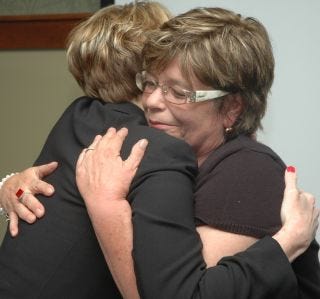Someone recently asked how we found the story behind Interview with a Serial Killer, which came out last week.
Here’s how it happened.
Back in 2022, I was talking with the famous forensic psychiatrist Katherine Ramsland. Katherine is the author of more than 60 books about the criminal mind, including Confession of a Serial Killer, for which she seems to have spent years corresponding with Dennis Rader, known as the BTK Killer. She’s a regular on 48 Hours and Dateline. I’d been curious for her thoughts on Juan David Ortiz, the Texas Border Patrol agent and serial killer and the subject of Gone South Season 3. Her view was that Ortiz may have had a brain injury and/or PTSD, but he was also a narcissist who was in control of his actions, and deserved the life sentence he got.
At the end of our conversation, I asked Katherine if she had any story ideas — something that hadn’t already received saturation coverage on the true-crime podcast and TV circuit. I braced myself for some scary serial killer ideas. Katherine didn’t disappoint. The one she mentioned involved Tommy Lynn Sells, who drifted around the country in the 80s and 90s and admitted to killing more than 50 people at the time of his capture in 2000.
I sighed. I didn’t want to think about serial killers again.
Then she told me about Diane Fanning.
A few years earlier, Katherine had published an article about Diane in Psychology Today called The Writer and the Murderer (a tip of the hat, I guess, to Janet Malcolm’s classic, and one of my favorite books, The Journalist and the Murderer). The piece chronicled the role that Diane, another prolific author of true-crime books, had played in getting the conviction of an Illinois woman named Julie Rea overturned.
Julie had been convicted of killing her 10-year-old son Joel. A few months later, Diane saw an episode of 20/20 about Julie’s case. She was writing a book about Tommy Lynn Sells at the time. And as she watched the episode unfold, she realized, to her amazement, that the details of the murder (a 4 am break-in, a knife taken from the kitchen) closely resembled Sells’s modus operandi.
Incredibly, Diane wound up eliciting a confession from Sells and writing it into her book, Through the Window, which was published in 2003. It was read by a private eye and founder of the Downstate Illinois Innocence Project. A few years later, Rea’s case was retried. She was found not guilty. Illinois exonerated her in 2006.
Many parties, including Northwestern’s Center on Wrongful Convictions, played a role in the outcome. But Diane set the whole thing in motion.
Here she is hugging Julie after receiving the Innocence Project’s Defender of the Innocent Award.
When I spoke with Diane about the story, I discovered that she’s not only a great storyteller (the type who gives you the cliffhangers and act breaks herself), she also has an audiobook-worthy voice. The story was too small to carry eight episodes of a limited series. But it was an obvious fit for a weekly show.
As always, we had to cut some fun material that didn’t quite fit. For example: Before Diane started her career as an author, she wrote a commercial for GE that wound up defining the company’s image in the 1980s. Perhaps you remember it. I do.
Diane also gave me some drawings that Tommy Lynn Sells sent her during their years-long correspondence, which Diane suffered through in the hopes that he would confess to other murders he committed around the country. He was executed before that happened.
Here’s a Christmas card Sells sent her around 2003.
Here’s the Mother’s Day card that Diane mentions in the episode. If her husband Wayne wasn’t already creeped out that his wife was visiting a serial killer in prison, this one pushed him over the edge.
He drew this one on an envelope. Not bad.
You can listen to the episode below. And learn more about Diane here. Thanks for reading.








